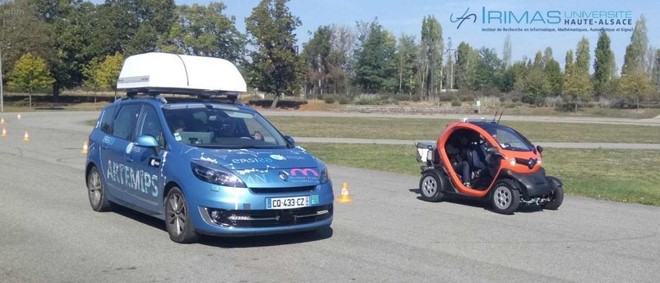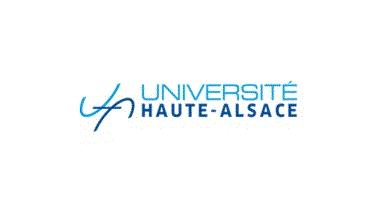|
|
Les membres du Laboratoire
Jérémie DANIEL
Post-Doctorant
Contact
 Université de Haute Alsace Université de Haute Alsace
Laboratoire MIPS, Ecole Nationale Supérieure d'Ingénieurs Sud Alsace (ENSISA)
12 rue des Freres Lumiere, 68093 MULHOUSE Cedex, France
Phone: +33 (0)3 89 33 69 57
Fax: +33 (0)3 89 42 32 82
Courriel : prénom.nom(at)uha.fr
Thématiques de recherche
Génération de trajectoires sous contraintes
- Splines Cubiques Parametriques
- Optimisation linéaire et quadratique
- Contrôle longitudinal et lateral de véhicules
- Contrôle de phares orientables
Fusion de données
- Théorie de Dempster-Shafer
- Fusion Multi-niveau Multi-critères
- Suivi Multi-hypothèses
- Détermination de vitesse limites
- Évaluation du risque de conduite
Thèse
Direction : Michel BASSET et Jean-Philippe LAUFFENBURGER
Financement : Bourse Régionale
Période : 10/2007-10/2010
Soutenance : 01/12/2010
Jury : Véronique Cherfaoui, Urbano Nunes, Thierry-Marie Guerra et Edouard Laroche
Intitulé de la thèse
Trajectory Generation and Data Fusion for Control-oriented Advanced Driver Assistance Systems.
Descriptif du sujet de thése
Since the origin of the automotive at the end of the 19th century, the traffic flow is subject to a constant increase and, unfortunately, involves a constant augmentation of road accidents. Research studies such as the one performed by the World Health Organization, show alarming results about the number of injuries and fatalities due to these accidents. To reduce these figures, a solution lies in the development of Advanced Driver Assistance Systems (ADAS) which purpose is to help the Driver in his driving task. This research topic has been shown to be very dynamic and productive during the last decades. Indeed, several systems such as Anti-lock Braking System (ABS), Electronic Stability Program (ESP), Adaptive Cruise Control (ACC), Parking Manoeuvre Assistant (PMA), Dynamic Bending Light (DBL), etc. are yet market available and their benefits are now recognized by most of the drivers.
This first generation of ADAS are usually designed to perform a specific task in the Controller/Vehicle/Environment framework and thus requires only microscopic information, so requires sensors which are only giving local information about an element of the Vehicle or of its Environment. On the opposite, the next ADAS generation will have to consider more aspects, i.e. information and constraints about of the Vehicle and its Environment. Indeed, as they are designed to perform more complex tasks, they need a global view about the road context and the Vehicle configuration. For example, longitudinal control requires information about the road configuration (straight line, bend, etc.) and about the eventual presence of other road users (vehicles, trucks, etc.) to determine the best reference speed. In addition, it requires several Vehicle information to determine its current configuration which allows to decide whether the Vehicle has to slow down or to accelerate. Regarding this example, it emerges that the relationships between the Reference, the Controller, the Vehicle, and the Environment have to be studied and refined.
The present PhD deals with both of these aspects: the constraints management and the information management between the Vehicle/Environment and the Controller/Reference:
1) Constraints involved by the Vehicle and its Environment are usually considered in the Controller synthesis step so that the latter could become complex or even impossible to obtain considering restrictive hypotheses. To reduce the complexity of the Controller, the first contribution consists in the distribution of the constraints over the Controller and/or the Reference. For the next ADAS generation, the Reference can be represented by the generation of unconstrained or constrained trajectories. Indeed, trajectories may provide a lot of information about the road context which can then be used for numerous applications. The contribution here lies in the definition of the trajectory generation as an optimization problem: considering constraints related to the Vehicle, to the Driver, and its Environment such as the road lane geometry given by a navigation system's Digital Map Database, the Vehicle minimal braking radius, the Driver acceleration limits, etc., a quadratic optimization looks for the optimal Parametric Cubic Spline coefficients while minimizing a predefined cost criterion. The comparison of different cost criteria allows to show that the minimization of the trajectory curvature is particularly interesting in the current power saving context. The validation of this approach is obtained through the comparison to an unconstrained trajectory generation over the longitudinal and the lateral control of a car-like Vehicle.
2) On the other hand, the management of the information is also of great importance as information may be inaccurate, redundant, erroneous, etc., thus may involve incoherent Controller behavior. The contribution, here, lies in the management of the information through Data Fusion. Indeed, the proposed fusion approach, based on the Evidence Theory, considers different levels of information, performing a multi-level fusion structure. The proposed fusion strategy is devoted to the combination of the information coming from a navigation and a vision system. One of the main contributions is to determine the navigation information through a multi-criterion fusion which considers each attribute of the Digital Map Database as an independent and specialized source. This multi-criterion fusion helps to detect and correct the navigation errors and inaccuracies in the Vehicle location. The benefits of the proposed solution are shown through its application to a Speed Limit Assistant defining the appropriate speed with respect to the contextual information provided by the navigation system and a speed sign recognition system.
Téléchargez le manuscrit
Publications
Articles de journal
- Mohammed BOUMEDIENE, Jean-Philippe LAUFFENBURGER, Jérémie DANIEL, Christophe CUDEL, and Abdelaziz OUAMRI. Multi-ROI Association and Tracking With Belief Functions: Application to Traffic Sign Recognition. In IEEE transactions on intelligent transportation systems (IF),
2014.
- Jérémie DANIEL and Jean-Philippe LAUFFENBURGER. Fusing navigation and vision information with the Transferable Belief Model: Application to an intelligent speed limit assistant. Information Fusion (IF),
2013.
- Jérémie DANIEL, Abderazik BIROUCHE, Jean-Philippe LAUFFENBURGER and Michel BASSET. Navigation-based Constrained Trajectory Generation for Advanced Driver Assistance Systems. International Journal of Vehicle Autonomous Systems (IJVAS),
2011.
Articles de conférence
- Mohammed BOUMEDIENE, Jean-Philippe LAUFFENBURGER, Jérémie DANIEL and Christophe CUDEL. Détection, association et suivi de pistes pour la reconnaissance de panneaux routiers. In Rencontres Francophones sur la Logique Floue et ses Applications (LFA 2014), Cargèse, France, 22-24 October, 2014.
- Jean-Philippe LAUFFENBURGER, Mohammed BOUMEDIENE and Jérémie DANIEL. Traffic Sign Recognition: Benchmark of Credal Object Association Algorithms. In International conference on Information Fusion (FUSION 2014), Salamanca, Spain, 7-10 July, 2014.
- Mohammed BOUMEDIENE, Jean-Philippe LAUFFENBURGER, Jérémie DANIEL and Christophe CUDEL. Coupled Detection, Association and Tracking for Traffic Sign Recognition. In IEEE Intelligent Vehicles Symposium (IV'2014), Dearborn, Michigan, USA, 8-11 June, 2014.
- Jean-Philippe LAUFFENBURGER, Jérémie DANIEL and Osamah SAIF. Multi-Object Association with Belief Functions: the Dual Decision Algorithm. In IFAC Workshop on Advances in Control and Automation Theory for Transportation Applications (ACATTA 2013), Istanbul, Turkey, 16-17 September, 2013.
- Jérémie DANIEL, Jean-Philippe LAUFFENBURGER, Sacha BERNET and Michel BASSET. Driving Risk Assessment with Belief Functions. In Intelligent Vehicles Symposium (IV'2013), Gold Coast, Australia, 26-28 June, 2013.
- Jérémie DANIEL and Jean-Philippe LAUFFENBURGER. Multi-Object Association Decision Algorithms with Belief Functions. In International Conference on Information Fusion (FUSION 2012), Singapore, 9-12 July, 2012.
- Rachid ATTIA, Jérémie DANIEL, Jean-Philippe LAUFFENBURGER, Rodolfo ORJUELA and Michel BASSET. Reference Generation and Control Strategy for Automated Vehicle Guidance. In Intelligent Vehicles Symposium (IV'12), Alcalá de Henares, Spain, 3-7 June, 2012. (oral session)
- Jérémie DANIEL and Jean-Philippe LAUFFENBURGER. Multi-level Dempster-Shafer Speed Limit Assistant. In International Conference on Belief Functions (BELIEF), Compiègne, France, 9-11 May 2012.
- Jérémie DANIEL and Jean-Philippe LAUFFENBURGER. Conflict Management in Multi-sensor Dempster-Shafer Fusion for Speed Limit Determination. In Intelligent Vehicles Symposium (IV'11), Baden Baden, Germany, 5-8 June 2011 (poster session).
- Jérémie DANIEL, Jean-Philippe LAUFFENBURGER and Michel BASSET. Multi-criterion Dempster-Shafer Fusion for Speed Limit Determination. In IFAC World Congress (IFAC WC '11), Milano, Italy, August 28 - September 2 2011.
- Jérémie DANIEL, Abderazik BIROUCHE, Jean-Philippe LAUFFENBURGER, and Michel BASSET. Energy Constrained Trajectory Generation for Advanced Driver Assistance Systems. In IEEE Intelligent Vehicles Symposium (IV'10), San Diego,CA, USA, 21-24 June 2010 (oral session).
- Jérémie DANIEL, Abderazik BIROUCHE, Jean-Philippe LAUFFENBURGER, and Michel BASSET. Génération de trajectoires sous contraites pour des systèmes d'aide à la conduite avancés. In Groupe de Travail en Automatique Automobile (GTAA), Mulhouse, France, 26-27 May 2010.
- Jérémie DANIEL, Chau TRUONG, Jean-Philippe LAUFFENBURGER, and Michel BASSET. Real-time Trajectory Generation for Advanced Driver Assistance Systems Applications. In International Forum on Strategic Technologies (IFOST09), Ho Chi Minh, Vietnam, 21-23 October 2009.
- Jérémie DANIEL, Gaétan POULY, Abderazik BIROUCHE, Jean-Philippe LAUFFENBURGER, and Michel BASSET. Navigation-based speed profile generation for an open road speed assistant. In 12th IFAC Symposium on Control in Transportation Systems, Redondo Beach, CA, USA, 2-4 September 2009.
- Abderazik BIROUCHE, Michel BASSET, Jérémie DANIEL, and Jean-Philippe LAUFFENBURGER. Trajectory Generation Combined with Tracking control: A New Approach. In European Symposium of Vascular Biomaterials, Strasbourg, France, 13-14 May 2009.
- Jérémie DANIEL, Gaétan POULY, Abderazik BIROUCHE, Jean-Philippe LAUFFENBURGER, and Michel BASSET. Navigation-aided Longitudinal Control. In IEEE Intelligent Vehicles Symposium (IV'2008), Eindhoven, The Netherlands, 4-6 June 2008. Note: Poster presentation and demonstrations on the IV 2008 Demo.
|
|




